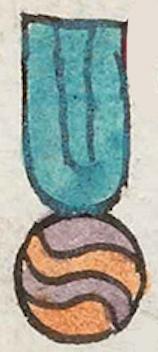tecihuitl (Mdz51r)
This compound glyph is also an element representing the noun hail (tecihuitl). It has been carved from the even more compound glyph representing the place name Teciuhtlan. The hail is shown as a vertical stream of water (atl), painted turquoise blue, and with a U-shaped line of current running through it. At the lower end of the stream is a round stone (tetl), which semantically represents the hailstone and small, round, and hard. It has the typical features of glyphs for stones, with its alternating, wavy stripes of purple and terracotta orange. The tetl also provides a phonetic indicator for the te- start to the word tecihuitl. Note, in the Digital Florentine Codex, references to snow (cepayahuitl), ice (cetl), and hail (tecihuitl) in Book 7, folio 13 recto.
Stephanie Wood
c. 1541, or by 1553 at the latest
Stephanie Wood
granizo, clima, tiempo, frío, helado, piedras, agua

tecihui, for hail to fall (verb), https://nahuatl.wired-humanities.org/content/tecihui-0
tecihui(tl), hail, the frozen rain (noun), https://nahuatl.wired-humanities.org/content/tecihuitl-0
el granizo
Stephanie Wood
Codex Mendoza, folio 51 recto, https://digital.bodleian.ox.ac.uk/objects/2fea788e-2aa2-4f08-b6d9-648c00..., image 112 of 118.
The Bodleian Libraries, University of Oxford, hold the original manuscript, the MS. Arch. Selden. A. 1. This image is published here under the UK Creative Commons, “Attribution-NonCommercial-ShareAlike 3.0 License” (CC-BY-NC-SA 3.0).

